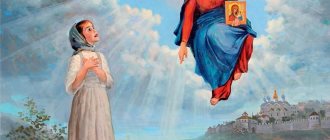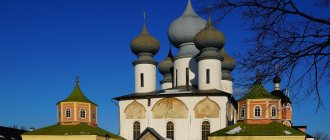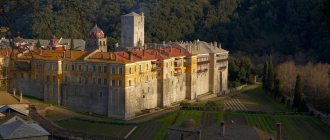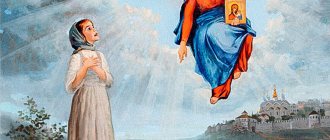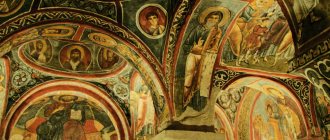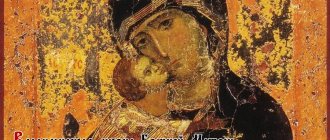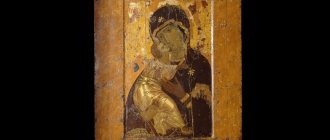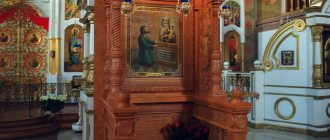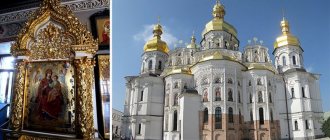Human life seems to many people to be the result of their actions and occasionally interfering circumstances. But in wars, natural disasters, incurable diseases, people always understood: many troubles or joys can only be explained by the will of God, lessons from the Lord, His punishment. That is why many trust in the Lord God and pray especially for the protection of the Kazan Icon of the Mother of God!
The meaning of the icon of the Kazan Mother of God
The Icon of the Kazan Mother of God also became famous during the disaster - Her image was found in the ashes after the terrible fire of 1579 in Kazan. More than half of the city was destroyed, and then the Mother of God Herself appeared in a dream to a little girl named Matrona, telling about the icon and promising Her protection to everyone who would pray in front of it.
For many people, a prayerful appeal to the Blessed Virgin in front of the icon of the Kazan Mother of God has become a way out in difficult life situations.
The icon belongs to one of the three most common iconographic types of images of the Mother of God “Hodegetria” - Guide. (It is believed that these three types were “invented” by the evangelist and icon painter Luke). The image of the Mother of God is painted from the waist up, although usually on icons like “Hodegetria” She points with her hand to the Child - on the Kazan Icon the Mother of God points at Him only with her head. Such a gesture means that the Virgin Mary presents Her Son to all people as the Way, the Truth and the Life. Dear friends, remember that on our pages you can always buy the Kazan Icon of the Mother of God inexpensively and quickly!
What to pray for in front of this image
What does the icon of the Kazan Mother of God protect from? Orthodox believers pray before this image in the following needs:
- Eye diseases.
- Getting rid of the invasion of enemies.
- Relief and strength in difficult times.
- Everyday difficulties.
Of course, this list cannot be called exhaustive. You can turn to the Mother of God in any need that may arise. Of course, we are talking only about helping in good deeds. By the way, before the shrine one must not only ask for the intercession of the Mother of God, but also thank Her for her intercession. Don't be ungrateful!
Also, according to the old tradition, parents and other older relatives bless those getting married with this icon. This image often becomes a wedding image. It is curious that “Kazan” is the most popular wedding icon in Russia. Therefore, this icon often becomes the first shrine of a young family.
Memorial Day and when is the holiday
The memory of the Kazan Icon is honored twice a year: July 21 (July 8, old style) - the memory of the discovery by the girl Matrona of the miraculous image on the ashes. This holiday has been celebrated by the entire Russian Orthodox Church since the 16th century; November 4 (October 22, old style) celebrates the assistance of the Queen of Heaven to the people's militia of Prince Minin and Pozharsky in victory over the Polish-Lithuanian invaders.
It is known that the miraculous copy of the Kazan Icon, through which the Mother of God helped the militia, was brought by them from Nizhny Novgorod. Led by Minin and Pozharsky, people prayed to the Mother of God before him, and miraculously defeated their powerful enemies. The holiday in honor of the Kazan Icon on November 4 has been celebrated by the Church since 1649.
It is also a national holiday, National Unity Day, in honor of the liberation of Moscow from the Poles by the people's militia in 1612 - this day is declared a holiday throughout Russia. After the 1918 revolution, the November 4 holiday was canceled, but by decree of Russian President Putin it was resumed in 2005.
On November 4 and July 21, services are held in front of the Kazan Icon. On these days, a special troparion is sung to the Kazan Icon of the Mother of God and a kontakion - a short hymn in honor of this particular image of the Mother of God: “Let us, people, come to a quiet and kind harbour, an ambulance, a ready and warm salvation, to the protection of the Virgin Mary. Let us try in prayer and repentance: after all, the Most Pure Mother of God gives us endless mercies, gives us help even before our prayer, delivers from various troubles and evil those who strive for a good life and who fear God, us, Her servants.”
Russian Orthodox Church
The celebration of the Mother of God on July 8 (today this day corresponds to July 21 according to the civil calendar) in honor of Her Kazan Icon begins with its miraculous appearance in Kazan in 1579. Some time after the conquest of Kazan by the young Tsar Ivan Vasilyevich the Terrible, his establishment of the Kazan diocese and After the successful spread of Christianity, the Mohammedans began to show strong resistance. The fire of 1579, which destroyed half of the Kazan Kremlin and the adjacent part of the city, they regarded as the wrath of the “Russian God.” It was at this time that to strengthen Orthodoxy in Kazan, the mercy of God was revealed through the miraculous discovery of the icon of the Mother of God, which on this occasion received the name Kazan.
Appearance of the miraculous icon
Matrona, the nine-year-old daughter of the archer Onuchin, who intended to build a new house for himself on the site of the fire, the Mother of God appeared in a dream, commanding her to inform the archbishop and mayors that they should remove Her image from the ground, indicating the place in the ashes where it was necessary to dig.
Since no one paid attention to the child’s words, the Mother of God appeared a second time, and the third time the girl in a dream saw the icon itself, from which came a menacing voice: “If you do not tell My words, I will appear in another place, and you will perish.” Then the mother of the frightened girl took her daughter to the governors and Archbishop Jeremiah, but no one believed the child’s words.
Finally, on July 8, the mother and her assistants began to dig as directed by her daughter, but only when the girl herself took up the spade and began to dig near the stove did an icon of the Mother of God appear, wrapped in an old cloth sleeve. The face of the icon was clear, as if it had just been painted, and had not been damaged at all by the fire (the iconography of the Kazan image is a type of Hodegetria the Guide). Having learned about the miracle, the archbishop and the mayors, in a solemn religious procession, came to the place of the miraculous discovery of the icon and transferred it to the Church of St. Nicholas of Tula, then, after a prayer service, to the Annunciation Cathedral.
The events of the appearance and transfer of the image were described by the priest of the St. Nicholas Church, Ermolai, the future Metropolitan of Kazan and then the Patriarch of Moscow Ermogen, who suffered as a martyr for Orthodoxy in troubled times. He also owns the service in honor of the Kazan Icon, including the well-known troparion: “The zealous Intercessor...”. He also witnessed the first miracles that happened during the celebration: on the way, Joseph, who had been blind for three years, received his sight; in the cathedral itself, another blind man, Nikita, was healed. Subsequently, the special mercy of the Mother of God through Her Kazan image to suffering eyes was also noticed.
After the archbishop and the governors sent the tsar a detailed description of the discovery of the icon with an exact list of it, he ordered a convent to be built on the site of the apparition. The first tonsures of the monastery were the youth Matrona and her mother. In 1595, Metropolitan. Hermogenes rebuilt the new Assumption Cathedral and increased the staff of nuns to 64 people; The miraculous image was surrounded by royal gifts - gold, precious stones and pearls. In 1798, new decorations were placed by Empress Catherine, and she also allocated 25 thousand rubles. for the construction of a new cathedral monastery church, consecrated in 1808.
Revered lists of the Kazan Icon
The Russian Church especially revered two miraculous copies from the Kazan image of the Mother of God, which twice accompanied the Russian army in the fight against foreigners: Moscow and St. Petersburg. The first list, after the secret appeal of Patriarch Hermogenes, taken by the Kazan squad on a campaign in 1611, was transferred to the squads of the northern cities under the leadership of Prince Dm. Pozharsky, who went to liberate the capital from the Poles.
After the fervent prayer of the Russian soldiers to the Mother of God in front of Her image, it became known about the vision of St. Sergius of Radonezh to the Greek Archbishop Arseny of Elasson, imprisoned by the Poles in the Kremlin, who announced to him that through the intercession of the Queen of Heaven, the reigning city was freed from enemies.
Having received such spiritual support from the Mother of God, on October 22 (today this day corresponds to November 4 according to the civil calendar), the Russians drove the Poles out of Kitay-Gorod, and then the invaders themselves surrendered the Kremlin. The clergy came out to meet the Russian army with Moscow shrines, and ahead of the liberators walked the Mounted Voivode Herself in Her Kazan image.
Until the new revolutionary unrest, this icon remained in the book built for it. Pozharsky Kazan Cathedral on Red Square. Since 1649, by order of Tsar Alexei Mikhailovich, local celebrations - Kazan on July 8 and Moscow on October 22 - became all-Russian, and the Kazan Icon began to be revered as the patroness of the House of Romanov.
The second revered list, which belonged to the Dowager Empress Praskovia Feodorovna, was transferred, among other shrines, by Emperor Peter the Great to the northern capital he was establishing, where it became one of the most important shrines of the city of St. Petra. In 1811, the Kazan Cathedral was built in honor of this image.
The next year, 1812, M.I. Kutuzov, appointed commander-in-chief of the Russian army by Emperor Alexander I, before leaving for the active troops, prayed in front of the St. Petersburg shrine and, by placing a holy icon on him, received the blessing of the Mother of God for the holy cause of fighting the invaders.
From silver looted by the French and taken by the Cossacks, Kutuzov built a silver iconostasis in the cathedral - a gift from the Mother of God. The ashes of the glorious commander, known for his piety, rested under the arches of the Kazan Cathedral next to the miraculous image of the Mother of God, who did not reject his prayers and, under his leadership, granted victory to the Russian army over the armies of Napoleon.
During the Great Patriotic War, when their strength was already running out, the residents of the blockaded city on the Neva made a religious procession with the Kazan Icon of the Mother of God, which undoubtedly added resilience to the believing townspeople and helped them survive to the end. Miraculously preserved during the revolutionary hard times, the St. Petersburg copy of the Kazan Icon is now kept in the Prince Vladimir Cathedral, awaiting its return to its place in the iconostasis of the Kazan Cathedral after its restoration.
The story of the revealed miraculous image sadly ended at a difficult time for Russia at the beginning of the 20th century. On the night of June 29, 1904, the cathedral of the Kazan Monastery was robbed by sacrilege; The miraculous icon of the Mother of God also disappeared without a trace. During the investigation, the thieves showed that they sold the precious robe, and chopped up and burned the icon. That same year, the Russian army suffered setbacks in the Far East.
In addition to these three icons, many other copies of the Kazan Icon of the Mother of God in different parts of our vast Motherland became famous for the miracles of healing and mercy of the Queen of Heaven to the Orthodox people, for which the Russian people loved this image very much. In a rare church you will not find the Kazan Icon; It is also most often used to bless young people for family life.
Return of the Honored List from the Vatican
After the revolution of 1917, the atheistic regime mercilessly dealt with the spiritual heritage of the Russian people and consistently destroyed shrines that were precious to the believer’s heart. Many icons, for the sake of their antiquity and rich frames, were auctioned off and fell into the hands of Western collectors.
One of the copies of the Kazan Icon of the Mother of God, written in the 18th century. and decorated with a precious frame and stones, was sold abroad, and then bought and presented to Pope John Paul II, in whose chambers the icon had been located since 1993. According to some assumptions, this icon belonged to the founder of the Diveyevo community, Schema nun Alexandra (Melgunova) and in her for a time it was kept in the Kazan Church in the village of Diveeva.
The desire to transfer this icon to the Russian Orthodox Church was expressed by the pope for a very long time. In 1997, the condition for the transfer was a personal meeting of the head of the Vatican with His Holiness Patriarch Alexy II, which was unacceptable for the Russian Church due to the complicated relations with Rome in recent years. In 2000, civil authorities became interested in the issue of returning the image, and the option of transferring the icon by the pope to the Patriarch in Kazan during the pontiff’s flight to Mongolia began to be considered.
In 2003, a mixed commission carried out an art history examination, which determined that the icon is not one of the three main images, but is a copy of the 18th century, made under the frame (that is, only the faces and hands are well depicted) and, judging by the frame belonged to a wealthy family.
After the examination, the Catholic administration again announced the possibility of John Paul II coming to Russia to hand over the icon, to which there was a negative reaction from the Synodal Department for External Church Relations. It indicated that the transfer of the icon was not a sufficient basis for the pope’s visit, and the visit itself by that time did not even appear as a subject of inter-church negotiations (Church Bulletin, No. 9-10 (262-263) May 2003).
Next year, 2004, the Catholic Church decides to transfer the list of the Kazan Icon without any conditions. On August 25, a solemn farewell to the icon took place in Rome, and on the feast of the Dormition of the Blessed Virgin Mary on August 15/28, 2004, during the Divine Liturgy in the Assumption Cathedral of the Moscow Kremlin, the venerable list was handed over by a delegation of the Roman Catholic Church led by Cardinal Walter Kasper, Chairman of the Pontifical Council to promote Christian unity, the Russian Orthodox Church in the person of its High Hierarch, His Holiness Patriarch of Moscow and All Rus' Alexy II.
The return of the Kazan image of the Mother of God to the Motherland is perceived, on the one hand, as the great mercy of God to the Russian people, and, on the other, as evidence of the good intentions of the Vatican to return to sincere relations with the Russian Orthodox Church, free from the unkind rivalry with which they have been overshadowed in recent times. decade. Until a decision is made on the permanent location of this image, it is kept in the home church of the working residence of His Holiness the Patriarch in Moscow.
Deacon Mikhail Asmus
What does it help with?
There are many images of the Mother of God, famous for their miracles: Kazan, Iverskaya, Tikhvin, Unfading Flower, Inexhaustible Chalice and many others. It is believed that through different icons the Mother of God helps in different needs.
Prayer is an appeal with sincere faith in the good will of God, in the fact that the Queen of Heaven Herself will direct your life for the better, a willingness to humbly accept and understand life’s lessons. When saying a prayer, you should not say words like a spell, but understand that you are speaking with the Most Pure Lady Theotokos. It is believed that in front of the Kazan Icon they pray: • for family well-being; • about a quick and happy marriage; • in case of danger of fire, about the rescue and recovery of fire victims, about preserving property from fire - since the icon was found unharmed in a burnt house; • with mental sorrows, depression; • in physical and mental illnesses; • for injuries, eye diseases, progressive blindness - as soon as the Kazan Icon was revealed, in 1579, after praying in front of it, a person was healed of three years of blindness.
A prayer to the Mother of God is a request for physical, mental and spiritual healing. The Most Holy Virgin will guide you on the true path; you just need to ask Her for help more often, visit the temple, and participate in the Sacraments of the Church.
The Kazan Icon of the Mother of God became famous for its help in a quick and happy marriage. Many girls testified that through prayers before her, they miraculously, unexpectedly met their future husbands. Russian artists of the 19th-20th even created a number of paintings depicting girls praying in front of Kazanskaya.
Lonely people can consider the Mother of God as their Patroness and pray for help to the Kazan Icon. Ask with confidence in the Mother of God, this is especially important if your chosen one or chosen one does not respond to love. Believe that the Mother of God will show you the right decision, maybe you will even be disappointed in your loved one, but this will only be for the better - it means that another person is waiting for you, who is more suitable for you.
Where can you pray in front of the Kazan Icon
- In the churches of the capital of Russia, where the revered lists of the image are located.
- In any temple where there are copies of the shrine.
- At home - in front of an icon purchased in an online store or church shop.
Unfortunately, the original of the miraculous icon, revealed in 1579, was stolen in 1904. We do not know whether it is stored anywhere or whether it was destroyed. If the Lord wills, the Orthodox world will again find the Kazan Icon. In any case, believers have the opportunity to venerate numerous copies of the icon.
If you do not have the opportunity to go to Moscow, where the original image is located, then there is no sin in this. Pray to the Mother of God in the temple or home closest to you. The main thing is that the prayer comes from a pure heart, and the request to the Most Pure Virgin is aimed only at a good cause.
We sincerely hope that the Most Holy Theotokos will hear your prayers!
How to pray to the Kazan Icon
Just as we communicate with different people in different ways, so we need to address God differently than people. • Do not demand benefits, because you are turning to the Queen of Heaven, but ask Her with faith, asking as a good Mother. • The words of prayer must be read with understanding. • Your appeal must be sincere and come from the depths of your soul. • You should not demand a quick marriage or the love of a specific person, but understand that the Mother of God knows better than you, perhaps a completely different happiness awaits you - even greater.
Do not be left alone with grief or difficulties, remember that the Lord is always with us, and a prayer to God or the Blessed Virgin Mary can be read at any time of the day.
Temple, Church of Our Lady of Kazan and Cathedral
The icon, originally acquired by a little girl, was destroyed in terrible wars. Her miraculous lists exist in Moscow, St. Petersburg and Kazan. The earliest of them is an image from 1606, which is located in the Tretyakov Gallery in the capital of Russia.
The list located in the Kazan Cathedral of the Northern capital, the main temple of the city, is very close to the original.
Monuments to M.B. Barclay de Tolly and M.I. Kutuzov at the Kazan Cathedral in St. Petersburg
All important events in the history of Russia were connected with the temple. From here, after a solemn prayer service, Field Marshal M.I. left for the active army. Kutuzov. And here in June 1813 the ashes of the great commander were delivered. Kutuzov's body was buried in a crypt built in the northern aisle of the temple. Captured banners and keys to cities that surrendered to the Russian army were placed nearby.
Monuments to M.I. Kutuzov and M.B. Barclay de Tolly organically fit into the architectural and sculptural ensemble of the temple. The figures of the commanders were cast from bronze according to the models of the sculptor B.I. Orlovsky. The monuments are identical: the commanders are depicted at full height, with cloaks thrown over their shoulders. But if the figure of Barclay is depicted waiting, then Kutuzov seems to be giving a signal to his troops to attack.
The prayer to the Kazan Icon of the Blessed Virgin Mary can be read online:
“O Great and Most Holy Lady of the whole world, Lady Theotokos!
With faith, love and awe, standing before Your miraculous icon, we beg You: do not turn away from those who come to You, ask, Merciful Mother of God, Your Son and our God, the Lord Jesus Christ, to save us from all evil and give us happiness in family life, saved our country from wars and civil strife, established His Holy Church from religious wars, schisms and persecutions. We have no other help, we have no other hope, except You, Pure Virgin, Mother of God: You are the All-Powerful Helper and Intercessor to all Orthodox Christians, to all believers who pray to You.
Deliver all of us who turn to You with faith and love from falls, from choosing the wrong path, from slander and intrigues of evil people, from all sorrows, from all grief, from sudden death. Grant, O Most Holy Lady, to our souls repentance, understanding and awareness of our sins, patience, humility and purity of thoughts! Help us correct our lives according to the commandments of God, so that we, with a pure heart and trembling soul, gratefully singing Your greatness, will be worthy of the Kingdom of Heaven, where, with all the holy saints of God, we rejoice and glorify You, Blessed Virgin, together with the Holy Trinity - Father, Son and Spirit Saints. Amen."
Through the prayers of the Heavenly Lady Theotokos, may the Lord protect you! Also, dear Friends, if you want to order the Kazan Icon of the Mother of God inexpensively and quickly, then this is easy to do with us!
Voice of the people
The peculiarity of the Kazan Icon of the Mother of God is that its glorification came “from below”, from the people, and not from church authorities and hierarchs.
This story is well known: in 1579 in Kazan, where Christianity had just appeared, the Mother of God appeared to nine-year-old Matrona in a dream and ordered her to “inform the archbishop and mayors so that they remove Her image from the ground,” indicating the place where to look.
Matrona told her mother everything, but she did not pay attention either the first or the second time. The third time, the icon itself was revealed to the girl in a dream, and the Mother of God repeated her order, warning that if Her words were not believed, the city would be in danger.
The frightened girl begged her mother to go to the priests. The mother took the child to Archbishop Jeremiah, but he did not believe the strange words of the nine-year-old child. Well, who would believe it?
But the girl did not want to calm down. Finally, the mother herself began to dig up the place where, according to Matrona, the icon was located. But only when a child took up the excavations did an icon appear, wrapped in cloth. The icon was completely “new”, as if it had not come from underground.
Rumors of the miracle quickly reached the archbishop's chambers. Amazed, Archbishop Jeremiah and the mayors hurried to Matrona’s house and in a solemn religious procession, with prayers, transferred the miraculously found image to the Annunciation Cathedral in the city of Kazan.
This wonderful event has its own documentarian, the glorified patriarch Hermogenes, who inspired the people to fight for faith and country in the Time of Troubles and was tortured to death by starvation in a prison basement.
At the time of the events described, he served as a simple priest in the St. Nicholas Church of Kazan and was called Father Ermolai.
“Reveal to yourself the icon of the Mother of God in the gray image,” wrote Fr. Ermolai. - Do not show the image of your Lady either to the saint of the city, or to the ruler of the ruler, below a noble or rich, below a wise old man: but show your honest treasure, an inexhaustible source to those who come with faith, your wonderful image, a certain man from the simple, who has wisdom in shooting war , this young woman, ten years old, named Matrona.
This wonderful maiden appeared and the blessed icon of the Theotokos. And after the fire in the same year and month, this maiden began to appear to her, her name was before the river, the icon of the Blessed Mother of God. And he wounded her in hail and cheerful about the icon of the Virgin Mary, the same Vid, the archbishop and governors, so that they would have the image of the Most Holy Theotokos from the Earthly: And the very one, I, more, follow the shallow of the Dragago Biser, an honest treasure, the icon of the Bogoroditsyn. ”
It was Patriarch Hermogenes who wrote the service in honor of the Kazan Icon and the famous troparion: “The zealous Intercessor...”.
At the site where the image was found, according to the royal decree (and with many gifts), a convent was built, the first nuns of which were Matrona and her mother.
What could be the meaning of what is reflected in the notes of Svshchmk. Patriarch Hermogenes some kind of opposition between power, might, wisdom - and the simplicity of a child?
You can remember the words of Christ about the child, whom He cited as an example, when the disciples began to argue about who was greater in the Kingdom of Heaven (Matthew 18: 1-6) “Jesus called the child, set him in the midst of them and said: Verily, I say to you , unless you are converted and become like children, you will not enter the Kingdom of Heaven; So whoever humbles himself like this child is the greatest in the kingdom of heaven. If you do not humble yourself as children, you will not enter the Kingdom of God.”
“Children are an image of those born again into the Kingdom of God, born of the Spirit,” says one of the interpreters. “Truly, truly, I say to you, unless someone is born again, he cannot see the kingdom of God,” Christ says to Nicodemus. (John 3:3).
The child is such an image of one reborn for the Kingdom of God, one who is no longer interested in the question: who is greater, me or my friend; who no longer evaluates himself or others according to the characteristics of this world: power, wealth, honor.
A child is one who has become “small” enough to joyfully need the Father, trusting Him in everything, following Him wherever He leads.
According to Jerome of Stridon, the child here is Christ Himself: “He placed Himself among them as a child, because He came to serve, and not to be served, so He set them an example of humility.”
“Such a child is the one who treats meek and humble people with love, like children, in the name of Christ, that is, in fulfillment of the commandment to love all the weak and humiliated, he will do this as to Christ himself,”
– adds Archbishop Averky Taushev.
Often, speaking about miraculous icons, people ask: what does it “help with?” When the Kazan image was transferred to the church, at the very first time two blind people received their sight (Patriarch Hermogenes also writes about this). Thus, it was noticed that the Mother of God of Kazan helps the “eyes.”
But a person consists of body and soul. And not only physical vision is strengthened by the Mother of God of Kazan, but also our spiritual vision - the ability to see things in the light of Christ, that is, in the True Light that enlightens the world - as a child sees, to see first of all the good in oneself, in others, in life .
